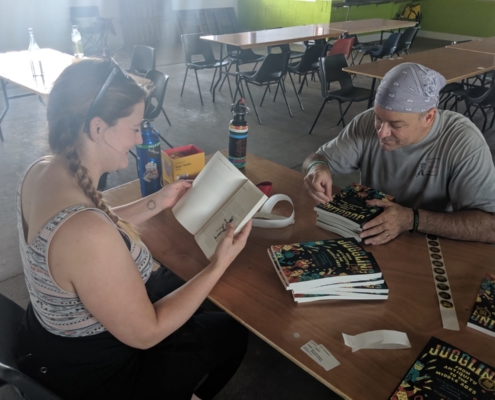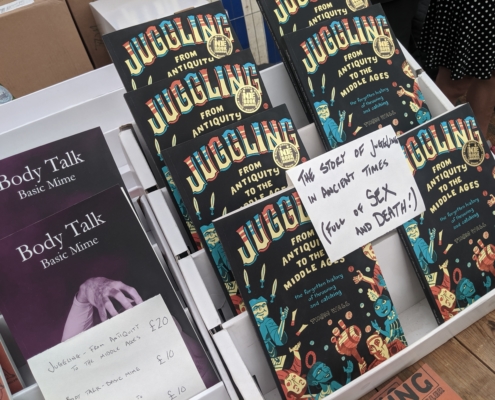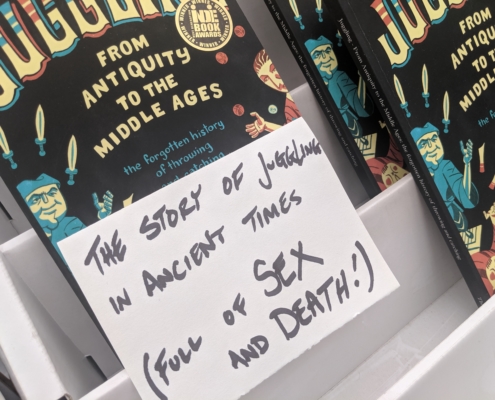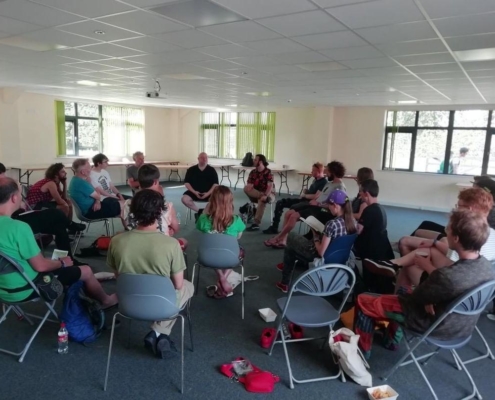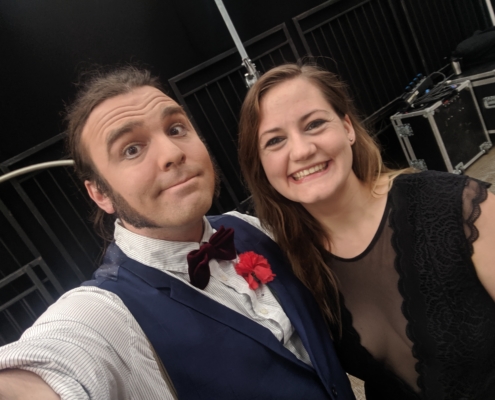EJC 2019
in which a new trick goes on stage
The European Juggling Convention (EJC) is the single largest gathering of jugglers around the world. This year was its 41st edition, and took place in Newark, England – a two hour train ride north of London. The nine-day-long festival drew some 4,000 jugglers from dozens of countries across the globe. We camped together, ate together, watched the same shows, trained, and drank coffees and beers elbow to elbow – if there wasn’t a common language, it didn’t matter – a smile, a wave, and a shared interest in circus is all you need to become fast friends in the juggling world.
I was invited to perform at the EJC gala show late in 2018, back when I was still working with Totem. When the email pinged in and I read the subject line back at my makeup table, I’m pretty sure my eyeliner slipped across my cheek as I showed my neighbor. This is incredible! I can’t believe they want me to perform! No matter what your resume looks like or how different your act is, when you grow up in the juggling community you’re always surprised, delighted, and encouraged by the support of your peers. And now my peers – the peers who were organizing the biggest juggling soiree in the universe – wanted me to close the gala show.
The EJC is big and long and I simply don’t have the memory or digital stamina to offer a minute-by-minute recap. In an effort to capture the flavor, I offer a series of vignettes that work towards some kind of thesis. (What is that thesis? The festival was good. The people there are good. And I think I did a good job in the show.)
Jugglers are Everywhere
If you’ve ever been to the Sturgis motorcycle rally, you doubtlessly recall the drive from wherever you started into the remoteness of the Black Hills. When you start out – say, in southern Colorado heading North – it’s all semi-trucks and panel vans and the occasional family heading North to go camping. When you’re a few hundred miles away from Sturgis, you start noticing motorcycles on the road… and then the closer you get to your destination, you come to discover that you’re the only vehicle with four wheels within miles and miles.
Heading to the EJC is like that, only switch “motorcycles” with “camping backpacks with juggling clubs sticking out of the top” and “dreadlocks” and “people absent-mindedly spinning a ballpoint pen between their fingers.”
Landing in Heathrow, I saw a few people with clubs tied to their rucksacks off in the distance. By the time I’d made it to King’s Cross for the connection to Newark, there were people on train platforms noodling with three ball patterns and enjoying pre-festival cans of beer. On my way to catch the train there, I saw a guy with a juggling festival shirt on, talking confusedly to a station agent – Hey Sagi! I shouted, realizing that the person who was lost was a juggling friend from Israel. Friend in tow, we got on the train and caught up about the last three years of our lives – last we saw one another was in Tel Aviv at the Israeli Juggling Convention where he saved my (proverbial) bacon time and time again by translating for me.
Judging the IRC
Juggling festivals in Europe have a long history of not involving competitions. Yes, there’s the Dutch National Juggling Championships and the British Young Juggler of the Year, but those are small and regional. The International Jugglers’ Association (for whom I served on the board for years and still volunteer when I’m able), was invited to hold a regional competition at the festival this year. The IJA’s regional competitions (IRCs, if you’ll pardon the slew of acronyms,) have been up and running for years – largely focusing on helping develop juggling performance in Mexico, Afghanistan, and dozens of other countries around the world. The IRC at the EJC was the very first in Europe, and the 33rd regional competition to be sponsored by the IJA.
I was invited to judge on a panel of five other performers and circus specialists. Without getting into the specifics, the event was crazy – totally insane acts that pushed technique to the limits. The public seemed satisfied with the results, the winners claimed medals, cash prizes, and a new item on their resume, and then I went straight to bed. Too much excitement for a guy with shows coming up later in the week!
(All that said, Alexis Levillon was a huge highlight for me. Any diabolo player that ends his top-notch routine with a run of tricks in galaxy? (that’s two diabolos, one in vertax and one in the regular plane…) Holy hannah. Incredible. You can see a clip of his routine over here.)
Wind
The EJC is a little village that pops up in the middle of a field. Shows are usually held in circus tents around the campus. The only issue this year? Wind.
Circus tents – no matter how big or small – have a wind rating. When gusts reach a certain speed, rigging inside starts to swing around, the side-walls can pick up, and they’re not a safe place to be. Unfortunately, right after the gala show performers finished their tech rehearsal the day before the show… the gusts exceeded the show tent’s rating and the show had to be moved.
When you’re working in a show and there’s an issue with the venue – be it a power outage or something else – the show is cancelled and the patrons get their money back or are issued a new ticket for another time. That’s not possible when we’re talking about wind and tents and jugglers in a field. What did the administrators at the EJC do? They got a crew of volunteers to literally dismantle the stage in the gala tent, set it all up in the main juggling hall, re-focus the lights, set out new seats, and get the show ready to go within 12 short hours.
Many of the acts (and I’m including myself in this,) were skeptical. Was this even possible? And yet – when the first gala show of the night started up, it was just as though they had planned for this venue all along. This kind of teamwork and execution is a testament to the coordinating team – a lesser group of organizers wouldn’t have been able to pull this off.
Books, books, books
This was Modern Vaudeville Press’ first foray into sales on a new continent. Yes, we’ve got contracts with shops around the world, but we’d never brought inventory to a festival in Europe before. We were set up right next to Gandini Press and Anthony Traihair (lovely humans that you should seriously get to know if you haven’t already,) and invited to sell our books to a curious public.
The result? We sold all but 15 copies of our five crates of books. Those final books were donated to the volunteer coordinators as a special thank-you to the folks who’d worked so hard in making the festival happen.
I was also invited to be a part of a few discussion panels with juggling historians David Cain and Charlie Holland. David is the expert on jugglers in the 19th & 20th centuries. Charlie is one of the world’s leading historians on British music halls at the turn of the century. And me? I guess my area of expertise is jugglers who aren’t just dead – so long-since dead that we’ve all forgotten their names. Really dead.
We ran three Q&A panels in a conference room tucked away in a corner of the EJC campus and dozens of people showed up with their trickiest stumpers for us to discuss. It was a lovely time, and a wonderful opportunity to talk about juggling research and its unique challenges.
A highlight
One afternoon before the day’s open stage show, I was hanging around with some friends near the bar tent. A woman walks up:
Are you Thom Wall?
Her eyes are puffy, as though she’s on the verge of tears.
Yes..?
Thank you. You are the reason I am here. You taught me everything I know about juggling.
Turns out, she learned to juggle from my blog. Then worked through every article on there and trained balance and juggling and used my practice methodologies. And now she was here.
You changed my life.
If that doesn’t make you feel good, you’ve got a heart of stone.
Two scenes from workshops
- “Juggling Sensei” Matt Hall stopped by my five ball workshop, which drew some 120 participants. He summed it up as “like a Baptist revival… only with juggling.” At the end of the 70-minute session, almost everyone broke the personal best with five objects.
- I taught a juggling and balance workshop at the beginning of the week. Later on in the week, I got an email – another juggler was slated to teach a similar workshop and didn’t show up. Frustrated, one of the would-be students there pulled up his notes from my class and led my workshop by proxy.
Closing the Gala
Back when Totem was in Japan, I dreamed up a trick. Then, for the next three years, I worked on it. It worked sometimes, but would fail as often as succeed.
It’s a version of the traditional (if we can call it that – it only dates back to the 60s) balloon popping mouthstick trick. The twist? Before you pop the balloon, you get it to change colors. While it’s still balanced on the sharp of a knife, with an object balanced on top of it.
The issue with new tricks – especially ones that are quite literally brand new and original – is that there’s a lot of faith involved. You just have to believe that it’s possible, identify issues as they come up, and find ways to overcome them. When you’re trying to pop one balloon that’s covering another balloon, while the balloon itself is at once being balanced and also balancing something else – you’ve got a number of variables to overcome, information to parse, and a whole lot of hope to try not to lose.
About two weeks before the EJC, I finally figured out the last piece in the puzzle – an issue I was experiencing that dealt with friction between the balloons and how they rested on the knife’s edge. I trained it slightly differently that afternoon and made the decision – I’m going to do this in the gala show.
Putting a new trick on stage is a mental game. Yes, you need to have the technique prepared and have the mechanics of the stunt in your body – but when you’re putting something on stage that you’ve never presented before, it’s easy to get nerves. Especially when it’s the last trick of the last act at the largest juggling festival in the world in front of 4,000 of your closest friends and colleagues.
Luckily, my friend Kathrin Wagner agreed to help me on stage during the show. Her help – and the encouraging smile as she handed me the balloon at the end of the number – helped ground me and keep me focus. And you know what? The trick worked both times and was the talk of the night amongst fellow variety performers.
Will I teach anyone how to do this trick? Maybe someday. But for now, it’s my signature – my little contribution to the field of balloons and mouthsticks – and I’m going to enjoy keeping it that way for a while.
Video by Luke Burrage



![picture [2]](https://thomwall.com/wp-content/uploads/2019/08/picture-2-495x400.jpg)
![picture [5]](https://thomwall.com/wp-content/uploads/2019/08/picture-5-495x400.jpg)

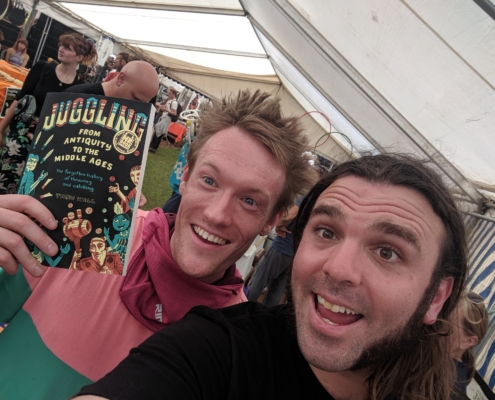


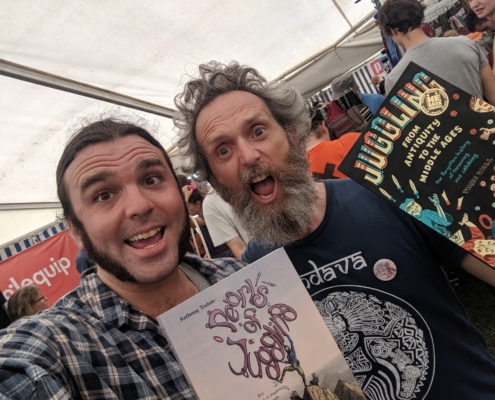

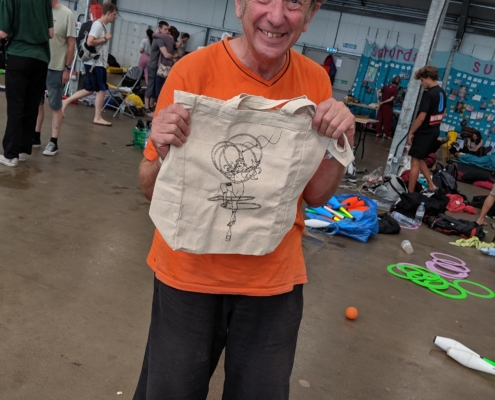

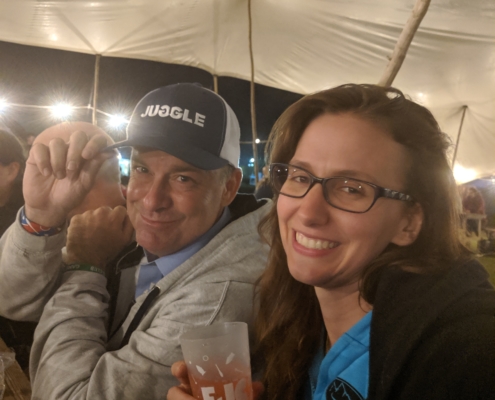
![picture [6]](https://thomwall.com/wp-content/uploads/2019/08/picture-6-495x400.jpg)


